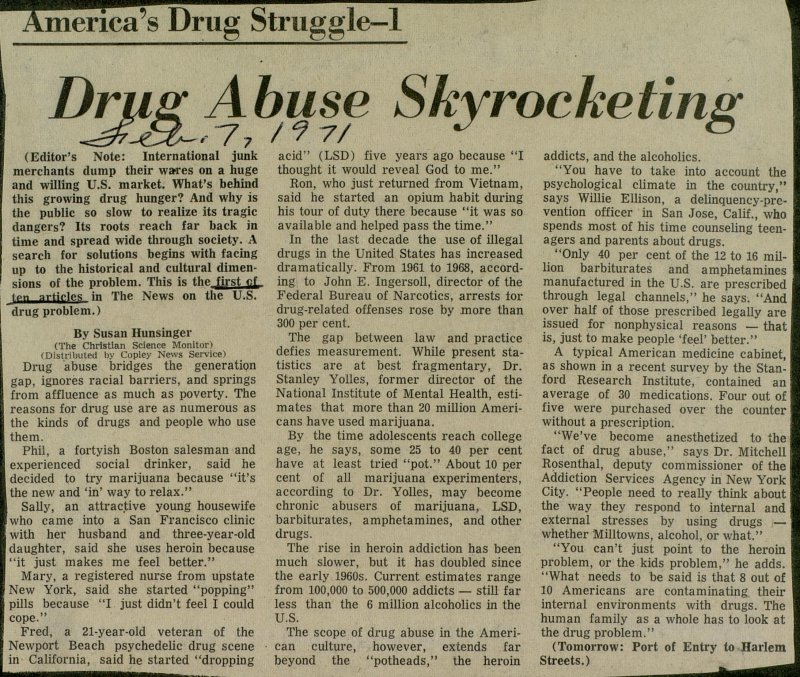Drug Abuse Skyrocketing

(Editor's Note: International junk merchants dump their wares on a huge and willing U.S. market. What's behind this growing drug hunger? And why is the public so slow to realize its tragic dangers? lts roots reach far back in time and spread wide through society. A search for solutions begins with facing up to the historical and cultural dimensions of the problem. This is the jfirst cf jpn arMff)ef 'n Tne News on the U.S. drug problem.) íDlstributed by Copley News Service) Drug abuse bridges the generation gap, ignores racial barriers, and springs from affluence as much as poverty. The reasons for drug use are as numerous as the kinds of drugs and people who use them. Phil, a fortyish Boston salesman and experienced social drinker, said he decided to try marijuana because "it's the new and 'in' way to relax." Sally, an attractive young housewife who carne into a San Francisco clinic with her husband and three-year-old daughter, said she uses heroin because "it just makes me feel better." Mary, a registered nurse from upstate New York, said she started "popping" pills because "I just didn't feel I could cope." Fred, a 21-year-old veteran of the Newport Beach psychedelic drug scène in California, said he started "dropping acid" (LSD) five years ago because "I thought it would reveal God to me." Ron, who just returned from Vietnam, said he started an opium habit during his tour of duty there because "it was so available and helped pass the time." In the last decade the use of illegal drugs in the United States has increased dramatically. From 1961 to 1968, according to John E. Ingersoll, director of the Federal Bureau of Narcotics, arrests lor drug-related offenses rose by more than 300 per cent. The gap between law and practice defies measurement. While present statistics are at best fragmentary, Dr. Stanley Yolles, former director of the National Institute of Mental Health, estimates that more than 20 million Americans have used marijuana. By the time adolescents reach college age, he says, some 25 to 40 per cent have at least tried "pot." About 10 per cent of all marijuana experimenters, according to Dr. Yolles, may become chronic abusers of marijuana, LSD, barbiturates, amphetamines, and other drugs. The rise in heroin addiction has been much slower, but it has doubled since the early 1960s. Current estimates range from 100,000 to 500,000 addicts - still far less than the 6 million alcoholics in the U.S. The scope of drug abuse in the American culture, however, extends far beyond the "potheads," the heroin addicts, and the alcoholics. "You have to take into account the psychological climate in the country," says Willie Ellison, a delinquency-prevention officer in San José, Calif., who spends most of his time counseling teenagers and parents about drugs. "Only 40 per cent of the 12 to 16 million barbiturates and amphetamines manufactured in the U.S. are prescribed through legal channels," he says. "And j over half of those prescribed legally are issued for nonphysical reasons - that is, just to make people 'feel' better." A typical American medicine cabinet, as shown in a recent survey by the Stanford Research Institute, contained an average of 30 medications. Four out of five were purchased over the counter without a prescription. "We've become anesthetized to the fact of drug abuse," says Dr. Mitchell Rosenthal, deputy commissioner of the Addiction Services Agency in New York I City. "People need to really think about the way they respond to internal and external stresses by using drugs - whether Milltowns, alcohol, or what." "You can't just point to the heroin problem, or the kids problem," he adds. "What needs to be said is that 8 out of I 10 Americans are contaminating their internal environments with drugs. The human family as a whole has to look at the drug problem." (Tomorrow: Port of Entry to Harlem Streets.) _
Article
Subjects
Susan Hunsinger
The Christian Science Monitor
Statistics
Stanford Research Institute
National Institute of Mental Health
Marijuana
LSD
heroin
Federal Bureau of Narcotics
Drugs
Drug Abuse
Amphetamines
Addiction Services
Ann Arbor News
Old News
Willie Ellizon
Stanley Yolles
Mitchell Rosenthal
John E. Ingersoll